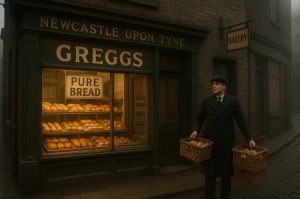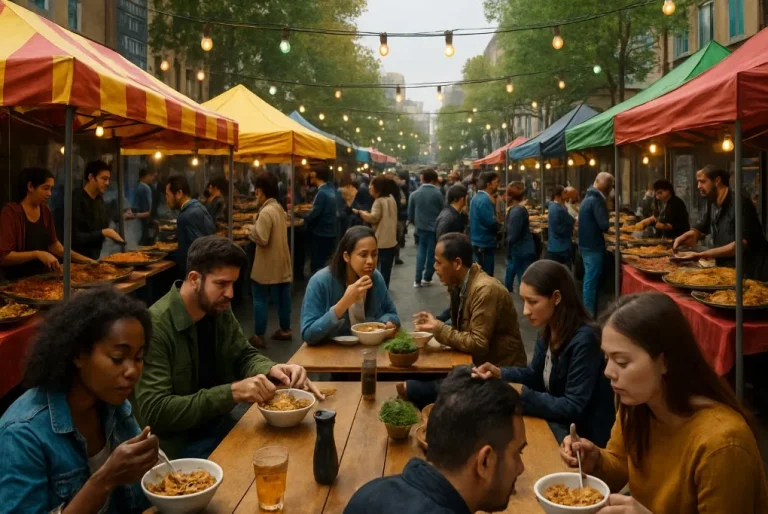Greggs, a name synonymous with British high-street food, has established itself as a leader in the “food-on-the-go” market.
Known for its sausage rolls, steak bakes, and fresh coffee, Greggs operates over 2,300 outlets across the UK, with a growing number of these stores run by franchise partners.
For entrepreneurs looking to invest in a reputable and proven brand, a Greggs franchise presents a compelling opportunity.
This comprehensive guide explores everything prospective franchisees need to know about the Greggs franchise cost, from initial investment and ongoing expenses to profit potential and the application process in 2025.
What Is The Background Of Greggs And How Did Its Franchise Model Evolve?

Greggs began as a small bakery operation in Tyneside in 1939. Its founder, John Gregg, started by delivering bread on his bicycle to local communities.
By 1951, he opened the first official Greggs shop in Gosforth, Newcastle upon Tyne. After his death in 1964, his sons Ian and Colin Gregg took over the business and led it into a new era of growth and expansion.
The transformation from a single-shop bakery to a national chain was driven by strategic acquisitions and a scalable operational model. By 2019, Greggs had more than 2,050 stores and employed over 23,000 people. In that same year, the company reported a 13% increase in sales, reaching £1.17 billion, with profits climbing by 27%.
Franchising became a significant part of Greggs’ expansion strategy. In 2019 alone, 45 out of the 138 new stores were franchise-operated. By 2020, Greggs planned to open an additional 100 outlets, 40 of which were designated as franchise stores.
Today, the brand operates over 300 franchise outlets, primarily in locations such as motorway service stations, petrol stations, airports, and convenience stores.
This hybrid model of both company-owned and franchise-operated stores has allowed Greggs to penetrate markets where direct ownership might not be practical or cost-effective.
How Does A Greggs Franchise Work In The UK?
A Greggs franchise provides an opportunity for approved business partners to operate a store using the Greggs brand and business model. This arrangement benefits both parties: the franchisee gains from the brand’s popularity, while Greggs extends its reach into non-traditional locations without direct operational management.
The model is not a typical franchise opportunity open to individual investors. Instead, it is aimed at established retail and food service operators capable of managing multiple outlets.
Franchisees are responsible for daily operations, staffing, and meeting brand standards. Greggs supports partners by offering operational frameworks and access to its supply chain. This includes assistance with store design, training, equipment, and marketing alignment.
Key aspects of how the Greggs franchise model works:
- A formal franchise agreement outlines roles, responsibilities, and rights to operate under the Greggs brand
- Store location, design, and fit-out are conducted in collaboration with Greggs
- Franchisees receive comprehensive training in operations, compliance, and customer service
- All supplies, including food and packaging, are sourced from Greggs’ centralised supply chain
- National marketing campaigns run by Greggs benefit all outlets, including franchises
What Services Does A Greggs Franchise Offer To Customers?
Greggs stores, whether company-owned or franchised, deliver a consistent menu and customer experience. The franchise outlets are strategically located to serve customers in high-footfall areas who seek convenience, speed, and affordability.
Services typically provided by Greggs franchise outlets include:
- Freshly baked savouries such as sausage rolls, steak bakes, and pasties
- Breakfast options like bacon rolls, omelette baguettes, and porridge
- Made-to-order sandwiches, wraps, and salads for lunch and light meals
- Hot beverages including barista-style coffee, tea, and hot chocolate
- An assortment of sweet products like doughnuts, cookies, and cakes
Additionally, many stores offer contactless ordering and loyalty rewards through the Greggs Rewards App, enhancing customer engagement and repeat business.
How Much Does It Cost To Start A Greggs Franchise?

Starting a Greggs franchise requires a significant upfront investment. This cost varies depending on the size, location, and customisation of the store.
Greggs does not publicly publish an exact franchise fee or revenue-sharing model, but industry research and franchise disclosures provide estimated figures.
Estimated Startup Costs for a Greggs Franchise
| Cost Component | Details | Estimated Cost Range |
| Franchise Licence Fee | Secures rights to operate under the Greggs brand | £25,000 – £30,000 |
| Equipment and Appliances | Ovens, counters, chillers, registers, and prep stations | £100,000 – £150,000 |
| Initial Stock | Ingredients and packaging for product preparation | £20,000 – £30,000 |
| Store Fit-Out | Layout, furniture, branding, and interior finishing | £120,000 – £180,000 |
| Total Investment | Combined initial costs required to launch the franchise | £260,000 – £390,000 |
These estimates may vary based on property costs, location size, and additional business infrastructure requirements.
What Are The Ongoing Costs Of Running A Greggs Franchise?
Operating a Greggs franchise involves regular expenses beyond the initial investment. These costs impact profit margins and should be carefully considered during the business planning phase.
Typical ongoing costs include:
- Royalty Fees: A portion of gross revenue is paid monthly to Greggs
- Marketing Contributions: Franchisees contribute to regional and national advertising campaigns
- Supply Chain Expenses: Ingredients and packaging sourced directly from Greggs’ distribution centres
- Utilities and Premises: Monthly rent, electricity, gas, water, and maintenance
- Staff Wages: Salaries for full-time and part-time employees, adjusted by location and store size
Example of Monthly Operational Expenses
| Expense Type | Estimated Monthly Cost |
| Royalty and Licence Fees | £2,000 – £5,000 |
| Supply Chain Purchases | £8,000 – £15,000 |
| Rent and Utilities | £3,000 – £7,000 |
| Staff Salaries | £8,000 – £12,000 |
| Marketing Contributions | £500 – £1,500 |
Managing these costs effectively while maintaining sales volume is crucial to achieving profitability.
How Much Profit Can A Greggs Franchise Generate?
Greggs does not disclose detailed earnings for individual franchises, but general expectations within the food franchise sector suggest annual returns between 10% and 20% on investment. This range can fluctuate depending on location, cost control, and customer demand.
High-traffic locations such as motorway services, train stations, and busy commercial areas tend to generate stronger returns due to consistent footfall and higher daily transaction volumes.
Profit margins are influenced by:
- Rental agreements and real estate costs
- Efficiency in staff scheduling and labour management
- Waste control and portion management
- Local competition and market demand
Experienced franchisees who have previously operated food or retail businesses often have an advantage in maximising profitability through operational efficiencies.
What Are The Requirements To Become A Greggs Franchisee?

Greggs maintains a selective franchise model and does not offer single-unit franchises to the general public. The company prefers working with partners who already have infrastructure in place and experience managing retail or hospitality businesses.
To be eligible, applicants must meet the following criteria:
- Financial Strength: Access to capital to fund the £260,000 – £390,000 investment
- Commercial Experience: A background in running retail, food service, or hospitality operations
- Multi-Unit Capability: Ability and intention to manage multiple locations over time
- Strong Business Proposal: A strategic plan that demonstrates growth potential and compliance with brand values
- Suitable Site: A proposed location that aligns with Greggs’ real estate strategy
Applicants must also pass a vetting and interview process that evaluates operational readiness, compliance track record, and commercial viability.
How Do You Apply For A Greggs Franchise In 2025?
Those interested in becoming a Greggs franchisee must go through a structured application process. This process ensures that only qualified and well-prepared applicants are approved.
The steps involved include:
- Completing an initial application on the Greggs corporate or franchise web page
- Undergoing an initial review of experience, financial position, and operational capacity
- Participating in an interview and business discussion with Greggs’ franchise team
- Submitting a detailed business plan and store location proposal
- Awaiting location assessment and final approval
- Signing a franchise agreement and attending training sessions
- Preparing and launching the store in partnership with Greggs support teams
The timeline for opening a store typically ranges from six to twelve months depending on location readiness, build requirements, and site approvals.
What Are the Advantages and Risks of Owning a Greggs Franchise?
Advantages:
- Established brand with national recognition
- Centralised logistics and quality assurance
- Continuous training and marketing support
- High footfall locations via established partnerships
- Strong customer loyalty and menu innovation
Risks:
- High initial investment cost
- Recurring royalty and operational fees
- Limited territory and single-unit access
- Subject to economic changes and consumer trends
Owning a Greggs franchise is a significant undertaking but offers robust support and a proven business model for the right partner.
How Does A Greggs Franchise Compare To McDonald’s, Subway, And Starbucks?

For those exploring franchise opportunities in the food and beverage industry, it’s essential to compare Greggs with other major players like McDonald’s, Subway, and Starbucks.
Each of these brands has its own strengths, financial requirements, and operational models. By evaluating them across five key criteria startup costs, profitability, brand presence, operational support, and return on investment—you can determine which option aligns best with your business goals.
Startup Costs: What Is The Financial Commitment?
Initial investment can be a decisive factor when selecting a franchise. The table below highlights the financial requirements for opening each brand.
| Franchise | Initial Investment | Liquid Capital Needed | Recurring Fees |
| Greggs | £260,000 – £390,000 | Varies (not publicly stated) | Royalties, supply chain charges |
| McDonald’s | £800,000+ | £150,000 | Royalties, national marketing fees |
| Subway | £80,000 – £225,000 | Varies | 8% royalty plus 4.5% advertising fee |
| Starbucks | £500,000+ | £500,000 | Royalties and promotional contributions |
Key Observations:
- Greggs offers a mid-range investment level, lower than Starbucks or McDonald’s but higher than Subway.
- McDonald’s has the most expensive entry point and a high liquid capital requirement.
- Starbucks requires a substantial financial commitment, making it best suited for investors with significant capital.
- Subway is the most budget-friendly to start, though its percentage-based ongoing fees are among the highest.
Revenue Potential: What Can Franchisees Earn?
Revenue and profit margins are central to evaluating any business opportunity. Here’s how each franchise performs financially.
| Franchise | Typical Annual Turnover | Estimated Profit Margin | Average Cash Flow |
| Greggs | Depends on store type & location | 10% – 20% ROI | Not disclosed publicly |
| McDonald’s | £1.5M – £4M | 15% – 20% | Around £550,000 annually |
| Subway | £250K – £500K | 10% – 15% | Not publicly available |
| Starbucks | £500K – £1M | 10% – 15% | Not publicly available |
Key Observations:
- McDonald’s delivers the highest average revenue and cash flow.
- Greggs offers solid ROI, depending on footfall, operational control, and site performance.
- Subway’s revenue is modest, reflecting its lower cost of entry.
- Starbucks produces decent sales figures, but the high setup and operational expenses may affect net earnings.
Brand Strength And Market Presence
Brand recognition influences customer trust and footfall. While all four brands are household names, their presence varies in scope and geography.
| Franchise | Brand Popularity | UK Locations | Global Footprint |
| Greggs | Well-known UK brand | 2,050+ | UK only |
| McDonald’s | Internationally dominant | 1,300+ | Over 38,000 stores worldwide |
| Subway | Global sandwich chain | 2,500+ | 37,000+ locations worldwide |
| Starbucks | Iconic global coffee brand | 1,156 | Around 35,000 stores globally |
Key Observations:
- McDonald’s holds the strongest global brand presence, with an unmatched international reach.
- Greggs dominates the UK high street but has no presence beyond British borders.
- Subway has more stores in the UK than McDonald’s, offering high accessibility.
- Starbucks is firmly positioned as the go-to premium coffee chain worldwide.
Franchise Support And Operational Setup
The level of training and support provided by the franchisor is critical for new and seasoned business owners alike. Here’s how each brand assists its franchisees:
| Franchise | Initial Training | Store Setup Assistance | Ongoing Franchise Support |
| Greggs | Comprehensive onboarding | Fully managed by Greggs | Continuous operational support |
| McDonald’s | Extensive and structured | Turnkey store rollout | Strong and regular support structure |
| Subway | Basic training included | Some guidance available | Minimal post-launch involvement |
| Starbucks | Advanced, high-level training | Full setup support | Ongoing mentoring and support |
Key Observations:
- McDonald’s is known for its rigorous training and extensive operational support.
- Greggs offers tailored support for UK operators, including training, supply chain access, and location assistance.
- Subway’s support is more limited after store launch, which may challenge less experienced operators.
- Starbucks provides thorough preparation and continues to support franchisees well after opening.
ROI And Break-Even Timeline
Understanding the return on investment and how long it takes to recover startup costs is essential for financial planning.
| Franchise | Annual ROI Estimate | Estimated Payback Time |
| Greggs | 10% – 20% | 5 to 7 years |
| McDonald’s | 15% – 20% | 3 to 5 years |
| Subway | 10% – 15% | 5 to 7 years |
| Starbucks | 10% – 15% | 6 to 8 years |
Key Observations:
- McDonald’s offers the fastest return, although it requires a much larger initial outlay.
- Greggs and Subway offer similar ROI percentages with mid-range payback periods.
- Starbucks’ longer payback time reflects its premium market position and higher operating costs.
Overall Comparison Summary
For UK-based entrepreneurs, a Greggs franchise offers a balanced opportunity between cost, brand power, and support. It’s more accessible than McDonald’s and Starbucks in terms of capital but backed by a strong national brand. Subway remains the lowest-cost entry point, though it may lack the support and scale of the other brands.
Summary Highlights:
- Lowest Cost Entry: Subway
- Highest Earnings: McDonald’s
- Best UK Market Focus: Greggs
- Global Reach Leader: McDonald’s
- Strong Franchise Support: McDonald’s and Greggs
Conclusion
Investing in a Greggs franchise in 2025 offers a strong opportunity for experienced operators seeking a trusted brand with nationwide appeal. While the initial investment is significant, the support, brand recognition, and proven business model make it a compelling choice.
With over 300 successful franchise locations across the UK, Greggs continues to be a leader in the food-on-the-go sector. For those ready to commit to quality, consistency, and customer satisfaction, Greggs offers a solid path to business success.
FAQs About Greggs Franchise Cost and Ownership
What is the average revenue for a Greggs franchise?
While exact figures aren’t published, industry sources suggest franchise locations in high-traffic areas can generate significant annual turnover, often exceeding £500,000.
Can individuals apply for a single Greggs franchise store?
Greggs primarily partners with corporate operators. Individuals without retail infrastructure are unlikely to be approved for a single unit.
How long does it take to open a Greggs franchise?
The process from application to store opening can take between 6 to 12 months, depending on location readiness and business plan approval.
Is Greggs a good investment in 2025?
Given its consistent growth, brand reputation, and product innovation, Greggs continues to be a reliable franchise investment in the UK market.
Do Greggs franchisees receive exclusive territories?
Greggs does not publicly disclose territorial agreements, but franchises are typically set up in specific types of locations like service stations or transport hubs.
Can you open a Greggs franchise without food industry experience?
While it’s possible, Greggs prefers applicants with experience in hospitality, retail, or food service sectors.
What support does Greggs provide to franchisees?
Support includes store design, training, supply chain access, IT systems, and national marketing—all crucial for smooth operations.








